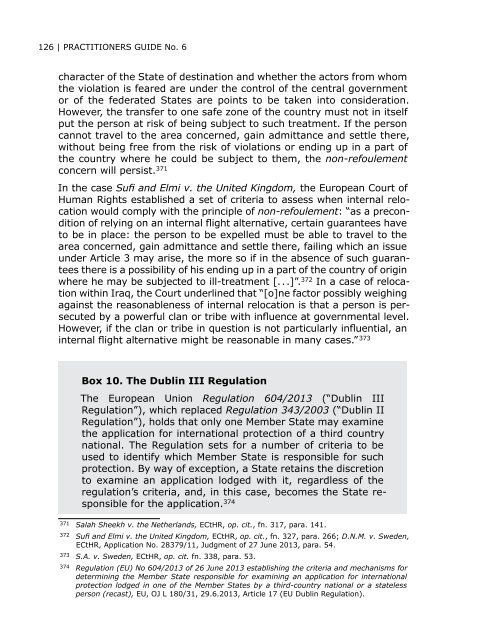Universal-MigrationHRlaw-PG-no-6-Publications-PractitionersGuide-2014-eng
Universal-MigrationHRlaw-PG-no-6-Publications-PractitionersGuide-2014-eng
Universal-MigrationHRlaw-PG-no-6-Publications-PractitionersGuide-2014-eng
Create successful ePaper yourself
Turn your PDF publications into a flip-book with our unique Google optimized e-Paper software.
126 | PRACTITIONERS GUIDE No. 6<br />
character of the State of destination and whether the actors from whom<br />
the violation is feared are under the control of the central government<br />
or of the federated States are points to be taken into consideration.<br />
However, the transfer to one safe zone of the country must <strong>no</strong>t in itself<br />
put the person at risk of being subject to such treatment. If the person<br />
can<strong>no</strong>t travel to the area concerned, gain admittance and settle there,<br />
without being free from the risk of violations or ending up in a part of<br />
the country where he could be subject to them, the <strong>no</strong>n-refoulement<br />
concern will persist. 371<br />
In the case Sufi and Elmi v. the United Kingdom, the European Court of<br />
Human Rights established a set of criteria to assess when internal relocation<br />
would comply with the principle of <strong>no</strong>n-refoulement: “as a precondition<br />
of relying on an internal flight alternative, certain guarantees have<br />
to be in place: the person to be expelled must be able to travel to the<br />
area concerned, gain admittance and settle there, failing which an issue<br />
under Article 3 may arise, the more so if in the absence of such guarantees<br />
there is a possibility of his ending up in a part of the country of origin<br />
where he may be subjected to ill-treatment [. . .]”. 372 In a case of relocation<br />
within Iraq, the Court underlined that “[o]ne factor possibly weighing<br />
against the reasonableness of internal relocation is that a person is persecuted<br />
by a powerful clan or tribe with influence at governmental level.<br />
However, if the clan or tribe in question is <strong>no</strong>t particularly influential, an<br />
internal flight alternative might be reasonable in many cases.” 373<br />
Box 10. The Dublin III Regulation<br />
The European Union Regulation 604/2013 (“Dublin III<br />
Regulation”), which replaced Regulation 343/2003 (“Dublin II<br />
Regulation”), holds that only one Member State may examine<br />
the application for international protection of a third country<br />
national. The Regulation sets for a number of criteria to be<br />
used to identify which Member State is responsible for such<br />
protection. By way of exception, a State retains the discretion<br />
to examine an application lodged with it, regardless of the<br />
regulation’s criteria, and, in this case, becomes the State responsible<br />
for the application. 374<br />
371 Salah Sheekh v. the Netherlands, ECtHR, op. cit., fn. 317, para. 141.<br />
372 Sufi and Elmi v. the United Kingdom, ECtHR, op. cit., fn. 327, para. 266; D.N.M. v. Sweden,<br />
ECtHR, Application No. 28379/11, Judgment of 27 June 2013, para. 54.<br />
373 S.A. v. Sweden, ECtHR, op. cit. fn. 338, para. 53.<br />
374 Regulation (EU) No 604/2013 of 26 June 2013 establishing the criteria and mechanisms for<br />
determining the Member State responsible for examining an application for international<br />
protection lodged in one of the Member States by a third-country national or a stateless<br />
person (recast), EU, OJ L 180/31, 29.6.2013, Article 17 (EU Dublin Regulation).



